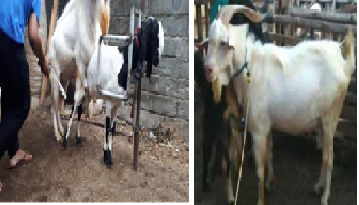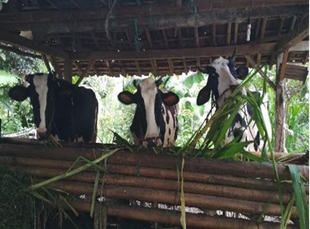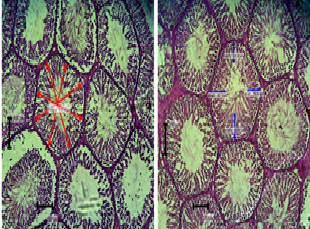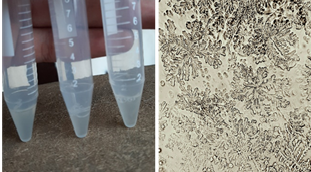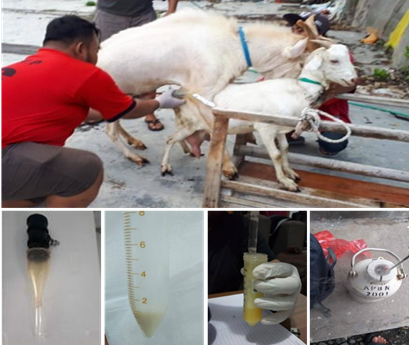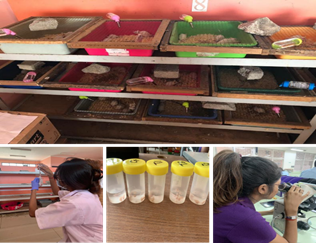Sex difference, growth pattern, and cephalic index of Turi ducks at different ages based on head morphometry
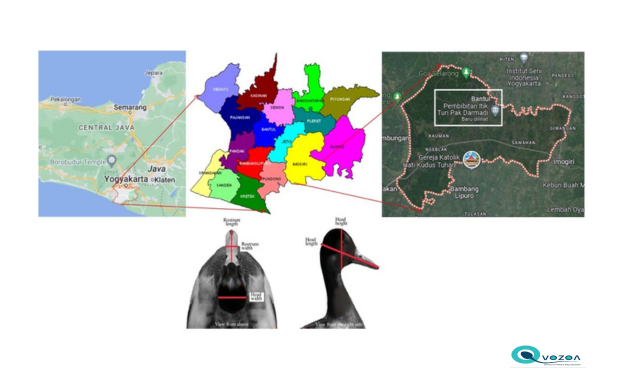
Downloads
This study aims to determine the morphometric differences in the head of male and female Turi ducks. Ten male and ten female day-old ducks (DOD) were randomly selected by a lottery system from the population, raised, and had their head morphology measured using a digital caliper with an accuracy of 0.01 mm on the first day, and at the age of 2, 4, 6, and 8weeks. The result showed that male Turi duck had wider (p <0.05) head at the ages of 1 day, 2 and 6 weeks, head length and head height at the ages of 1 day, 2, 4, 6, and 8 weeks, rostrum width at the ages of 1 day, 4, 6, and 8 weeks, and rostrum length at the age of 2, 4, 6 and 8 weeks. There were no significant differences (p >0.05) in the head width at the ages of 4 and 8 weeks, rostrum width at 2 weeks, and rostrum length at 1day old male and female Turi ducks. Morphometric growth pattern showed that older Turi ducks (at a range of 1 day to 8 weeks) had larger (p <0.05) head morphometry. However, the cephalic index in male and female Turi ducks was not significantly different (p > 0.05) at all ages. It could be concluded that in general head morphometry was useful for determining male and female Turi ducks at the ages of 1 day, 2, 4, 6, and 8 weeks
Abd El-Hack ME, Hurtado CB, Toro DM, Abdelfattah EM. 2019. Fertility and hatchability in duck eggs: A comprehensive review. World’s Poult Sci J. 75: 1-9.
Absalan F, Moghadam ARE, Rezaian J. 2023. Morphometric cranial standards for sex estimation of a population in two ethnic groups in Southwest Iran. Trans Res Anat. 31: 100249.
Akinbami BO. 2014. Measurement of cephalic indices in older children and adolescents of a Nigerian population. Biomed Res Int. 2014: 527473.
Ancona S, Liker A, Carmona-Isunza MC, Székely T. 2020. Sex differences in age-to-maturation relate to sexual selection and adult sex ratios in birds. Evol Lett. 4: 44-53.
Atterholt J, Woodward HN. 2021. A histological survey of avian post-natal skeletal ontogeny. Peer J. 9: e12160.
Ball GF, Wade J. 2013. The value of comparative approaches to our understanding of puberty as illustrated by investigations in birds and reptiles. Horm Behav. 64: 211-4.
Beck HE, Zimmermann NE, McVicar TR, Vergopolan N, Berg A, Wood EF. 2020. Present and future Köppen-Geiger climate classification maps at 1-km resolution. Sci Data 7: 274.
Bourgeois K, Dromzée S, Welch JE, Russell JC. 2017. Sex and geographic variation in grey-faced petrel (Pterodroma gouldi) morphometrics. Waterbirds 40: 144-153
Canoville A, Schweitzer MH, Zanno LE. 2019. Systemic distribution of medullary bone in the avian skeleton: ground truthing criteria for the identification of reproductive tissues in extinct Avemetatarsalia. BMC Evol Biol. 19: 71.
Dayan MO, Demiraslan Y, Akbulut Y, Duymus M, Akosman MS. 2014. The morphometric values of the native duck and gooses' heads: A computed tomography study. Anim Vet Sci. 2: 175-8.
Dewanti R. 2010. The effect of sires and feed on the genotype of Turi duck growth. Caraka Tani: J Sust Agric. 25: 50-4.
Diaz-Figueroa O, Mitchell MA. 2006. Gastrointestinal anatomy and physiology. In: Divers SJ, Douglas R. Mader (Eds). Reptile medicine and surgery. 2nd Ed. WB Saunders. 145-62,
Firdaus M, Samik A, Dhamayanti Y, Adikara RTS, Eliyani H, Soeharsono S. 2022. Cranium morphometry for distinguishing male and female Muscovy duck (Cairina moschata) before sexual maturity. Ovozoa: J Anim Reprod. 11: 54-8.
Fouad AM, Ruan D, Wang S, Chen W, Xia W, Zheng C. 2018. Nutritional requirements of meat-type and egg-type ducks: what do we know? J Anim Sci Biotechnol. 9: 1.
Fu Y, Zhou J, Schroyen M, Zhang H, Wu S, Qi G, Wang J. 2024. Decreased eggshell strength caused by impairment of uterine calcium transport coincide with higher bone minerals and quality in aged laying hens. J Anim Sci Biotechnol. 15: 37.
Ghassani AF, Depison D, Ediyanto H. 2022. Association of quantitative characteristics with growth hormone gene (GH Gene) in Kerinci duck using PCR-RFLP method. Buletin Peternakan 46: 248-56.
Hanif A, Nugroho F. 2018. Turi duck egg quality in Kretek sub district, Bantul regency, Special Region Yogyakarta as original germplasm of Indonesia. Conference: International Poultry Science Congress of WPSA Turkish Branch 9-12 May 2028. 643-8.
Hecht EE, Smaers JB, Dunn WD, Kent M, Preuss TM, Gutman DA. 2019. Significant neuroanatomical variation among domestic dog breeds. J Neurosci. 39: 7748-58.
Ismoyowati I, Tugiyanti E, Mufti1 M, Purwantini D. 2016. Sexual dimorphism and identification of single nucleotide polymorphism of growth hormone gene in muscovy duck. J Indones Trop Anim Agric. 42:167-174.
Kadurumba OE, Agu CI, Ikpamezie LC, Ahiwe EU, Iloeje MU, Gundu UE, Koli IC, Koro VMO, Kadurumba C. 2021. Morphological and morphometric characterization of local duck population in South-east ecological zone of Nigeria. Nigerian J Anim Sci. 23: 8-17.
Kokoszyński D, Wasilewski R, Saleh M, Piwczyński D, Arpášová H, Hrnčar C, Fik M. 2019. Growth performance, body measurements, carcass and some internal organs characteristics of Pekin ducks. Animals 9: 963.
Livolsi MC, Williams CJ, Coluccy JM, DiBona MT. 2015. Morphometrics of mid-Atlantic dabbling ducks for use in thermoregulation models. The Condor 117: 644-9.
Lv G, Zeng Q, Ding X, Bai S, Zhang K. 2022. Effects of age and diet forms on growth-development patterns, serum metabolism indicators, and parameters of body fat deposition in Cherry Valley ducks. Anim Biosci. 35: 247-59.
Marugán-Lobón J, Nebreda SM, Navalón G, Benson RBJ. 2022. Beyond the beak: Brain size and allometry in avian craniofacial evolution. J Anat. 240: 197-209.
Meteorology, Climatology, and Geophysics Agency (MCGA). 2024. Bantul district Bantul regency - DI Yogyakarta province.
Mori E, Mazza G, Lovari S. 2017. Sexual dimorphism. In: Vonk J, Shackelford T (Eds). Encyclopedia of animal cognition and behavior. Springer International Publishing, Switzerland. 1-7.
Pagnon T, Etchart L, Teixeira M, Dechaume-Moncharmont F-X, Hallgrimsson GT, Hansen J, Lang J, Moreau J, Reneerkens J, Schmidt NM, Soloviev M, Horn Jt, Tomkovich P, Wood AG, Yannic G, Bollache L, Gilg O. 2024. Using a common morphometric-based method to sex a migratory bird along its entire flyway despite geographical and temporal variations in body size and sexual size dimorphism. J Ornithol 2024: 1-12.
Pazvant G, İnce NG, Özkan E, Gündemir O, Avanus K, Szara T. 2022. Sex determination based on morphometric measurements in yellow-legged gulls (Larus michahellis) around Istanbul. BMC Zool. 7: 35.
Seema S, Verma P. 2016. The study of cephalic index in North Indian population. Int J Morphol. 34: 660-4.
Squire ME, Veglia MK, Drucker KA, Brazeal KR, Hahn TP, Watts HE. 2016. Estrogen levels influence medullary bone quantity and density in female house finches and pine siskins. Gen Comp Endocrinol. 246: 249-57.
Süzer B, Serbest A, Arican İ, Yonkova P, Yilmaz B. 2018. A morphometric study on the skull of the turkeys (Meleagris gallopavo). Uludağ Üniv Vet Fak Derg. 37: 93-100.
Ungkusonmongkol P, Wattanachant S. 2024. Carcass characteristics and meat quality of spent laying ducks for potential additional supply to the duck meat market. J Appl Poul Res. 33: 1-17.
Yin X, Wu Y, Zhang S, Zhang T, Zhang G, Wang J. 2021. Transcriptomic profile of leg muscle during early growth and development in Haiyang yellow chicken. Arch Anim Breed. 64: 405-16.
Zhang X, Li J, Chen S, Yang N, Zheng J. 2023. Overview of avian sex reversal. Int J Mol Sci. 24: 8284.
Zhu YW, Wen J, Jiang XX, Wang WC, Yang L. 2018. High calcium to phosphorus ratio impairs growth and bone mineralization in Pekin ducklings. Poult Sci. 97: 1163-9.
Copyright (c) 2024 Bangun Nur Wijaya, Yeni Dhamayanti, Sri Mulyati, Soeharsono Soeharsono, Sunaryo Hadi Warsito, Sri Hidanah

This work is licensed under a Creative Commons Attribution-ShareAlike 4.0 International License.
Ovozoa by Unair is licensed under a Creative Commons Attribution-ShareAlike 4.0 International License.
1. The journal allows the author to hold the copyright of the article without restrictions.
2. The journal allows the author(s) to retain publishing rights without restrictions
3. The legal formal aspect of journal publication accessibility refers to Creative Commons Attribution Share-Alike (CC BY-SA).
4. The Creative Commons Attribution Share-Alike (CC BY-SA) license allows re-distribution and re-use of a licensed work on the conditions that the creator is appropriately credited and that any derivative work is made available under "the same, similar or a compatible license”. Other than the conditions mentioned above, the editorial board is not responsible for copyright violation.





























